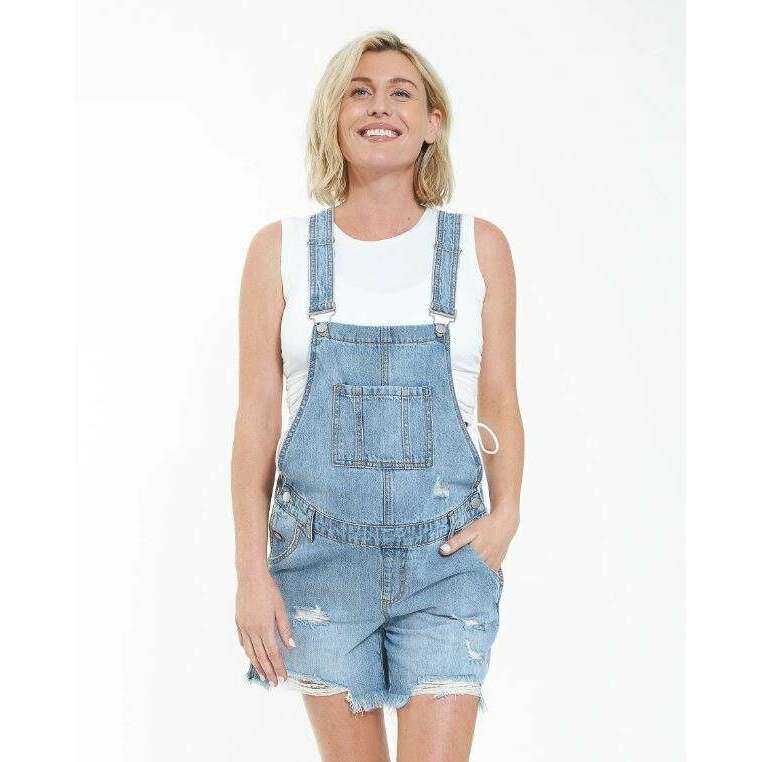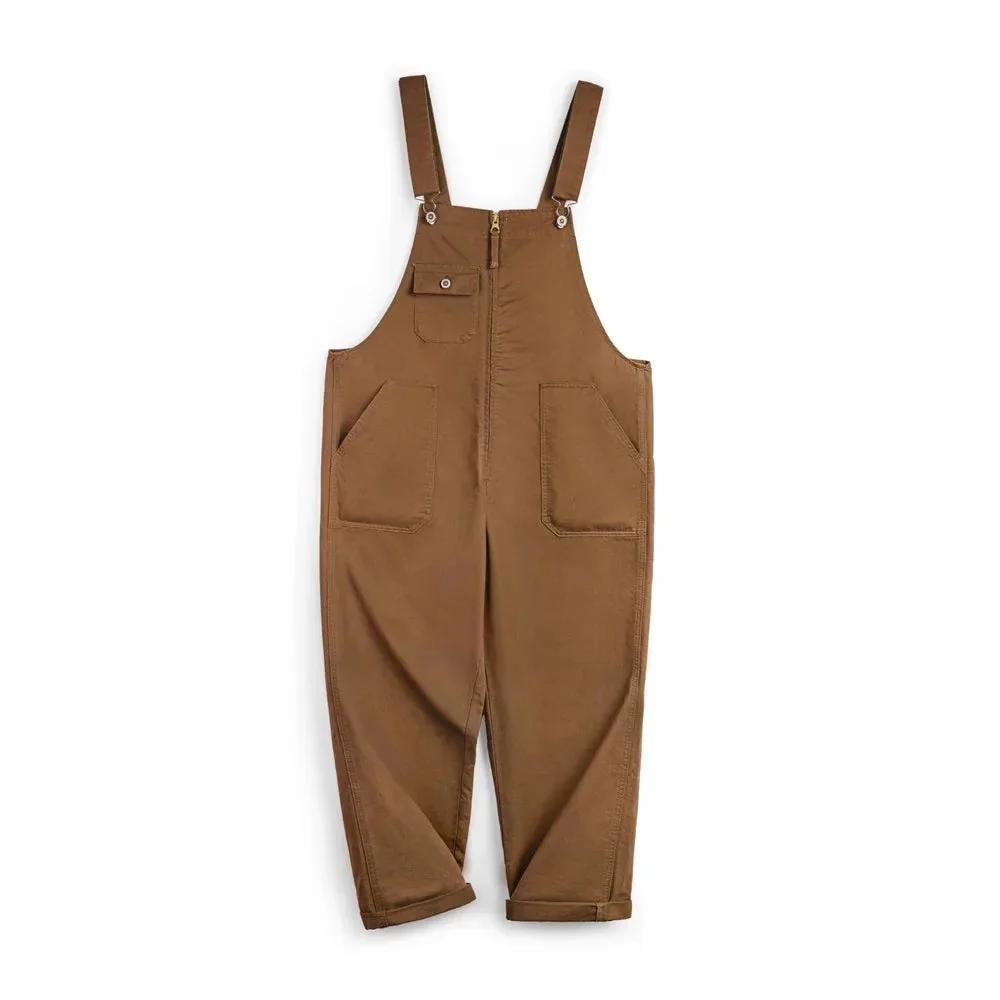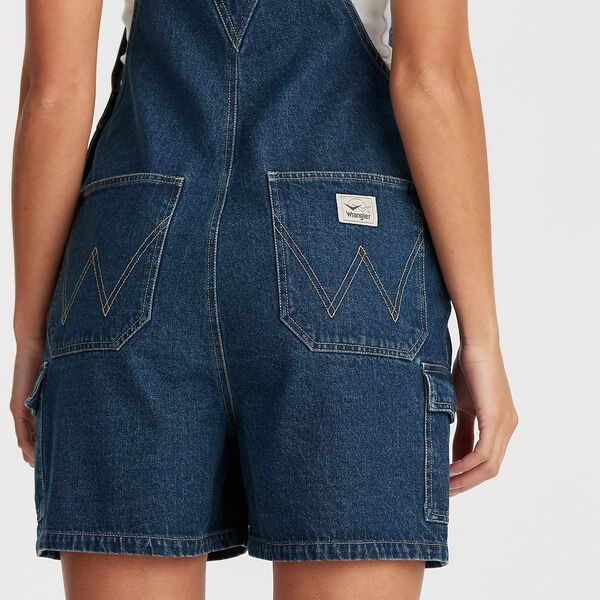Introduction to Dungarees and Overalls
Dungarees vs overalls! In the world of rugged and casual workwear, comparisons often arise between dungarees vs overalls. Although the terms are frequently used interchangeably, they refer to distinct garments with their own characteristics. Dungarees originated as a durable work pant, often crafted from heavy-duty denim or thick cotton. The term now signifies a particular style of overalls featuring a bib, attached straps, and multiple pockets.
Overalls, on the other hand, serve a similar purpose but come with their own unique features. They consist of a full-frontal bib, and secure straps, and may extend to cover more of the body. Overalls are also incredibly versatile. They work as protective outer layers and fit various professions. From the fields to the workshops, overalls are a common sight.
Understand these differences not only aids in making informed clothing choices. It also sharpens one’s fashion judgment. We will delve into the origins, characteristics, and styling of the two. This will uncover the nuances between dungarees and overalls. Our aim is to guide readers in distinguishing between them with ease. Whether for work, casual outings, or even semi-formal environments, grasping these distinctions is crucial for anyone’s wardrobe.
Historical Background of Dungarees and Overalls
Dungarees trace their roots to 17th-century India. Here the word “Dungri” referred to a type of calico cloth. Laborers wore pants made from this durable material. The garment soon gained notoriety among British sailors and merchants. Over time, dungarees became synonymous with heavy-duty work pants.
Overalls’ history begins in the fields and factories of America in the early 20th century. They were first recognized as a practical solution for workers’ clothing needs. The full-body coverage offered protection against grime and injury. Overalls quickly earned a reputation as the go-to workwear for physical labor.
The evolution of these garments reflects social and industrial changes. Dungarees and overalls adapted as work environments grew more varied. They moved from purely functional gear to fashion statements. Today, they evoke a sense of nostalgia while providing practicality and style.
Throughout history, both dungarees and overalls have shared the spotlight in various social movements. They have symbolized strength and resilience among workers. Their adoption into mainstream fashion also indicates inclusivity and comfort.
Understanding their historical significance enriches our appreciation for dungarees vs overalls. It offers insights into the cultural fabric they represent. It is not just a matter of workwear but a narrative of human progress and style evolution.

The Physical Differences: Cut and Construction
When delving into the dungarees vs overalls debate, physical differences can’t be overlooked. The cut and construction set them apart, defining each garment’s identity. Let’s break down these differences in simple terms.
For dungarees, the signature look includes a bib front that often has one large central pocket. They have straight-cut legs and sometimes incorporate side buttons for ease of wear. Typically, dungarees fit snugly around the waist and hips before loosening slightly at the legs.
Overalls extend this concept further. They usually have a full-frontal bib that provides greater chest coverage. Straps over the shoulders secure the bib in place. Unlike dungarees, overalls often cover the entire torso and may include a connected top, offering full coverage. They also frequently feature side and back pockets, in addition to the bib pocket.
The construction of overalls allows for more room around the waist and hips, making them ideal for active work. The cut is designed to offer freedom of movement, which is crucial for workers bending, lifting, or performing various tasks.
Material use in construction also varies. Dungarees are typically made of thick, durable denim. Overalls can be found in a range of fabrics, from lightweight cotton to heavy-duty canvas, based on their intended use. Both dungarees and overalls are reinforced with strong seams to endure rigorous wear and tear.
Understanding these physical distinctions is important for choosing between dungarees vs overalls. It affects comfort, mobility, and suitability for specific tasks or occasions. Whether it’s for a hard day’s work or a casual outing, knowing the cut and construction helps in making the best pick.

Materials and Durability: What Are They Made Of?
When examining dungarees vs overalls, materials and durability play a key role. Dungarees are often crafted from robust denim. This fabric is known for its toughness and ability to withstand heavy wear. Denim’s thick weave offers substantial protection, making dungarees a durable choice for work environments.
Overalls also boast durable materials, but their range is broader. They might be made from denim, canvas, or even lightweight cotton for less intensive tasks. The choice of material affects the overall’s durability. Canvas, like denim, is particularly resistant to wear and ideal for demanding jobs.
Some overalls are designed from specialty fabrics. These materials may be water-resistant or flame-retardant. Such features cater to specific work conditions. Workers in hazardous environments benefit from these enhanced protective qualities.
Both garments often have metal fastenings like buckles and buttons. These components add to their resilience. Reinforced stitching at stress points ensures they can handle the strains of repetitive motion and long hours.
The fabric’s weight also dictates its use. Heavier fabrics suit colder climates or rough tasks. Lighter materials might be chosen for comfort during warmer weather or less strenuous activities.
Thus, dungarees and overalls offer varying levels of durability based on their construction materials. Their longevity and performance depend on the user’s needs and the demands of their activities.
Fashion and Functionality: How to Style Them
When considering dungarees vs overalls, style is just as important as function. Dungarees, with their snug fit and straight-cut legs, lend themselves to a streamlined silhouette. Pair them with a fitted t-shirt or a casual button-up to maintain a sleek look. For a more street-style edge, roll up the legs and add sturdy boots or sneakers.
Overalls, given their roomier cut, invite a relaxed vibe. They can be styled with loose-fitting shirts or even layered over sweatshirts for added warmth. Women often style overalls with crop tops or high-neck blouses for a feminine touch. Adjusting the strap length can change the overall fit and look.
Both garments can be worn with a variety of footwear. Boots, work shoes, or even sandals complement their casual nature. Consider the occasion and your personal style when choosing your shoes.
Accessorizing with dungarees or overalls is straightforward. A simple hat or a beanie adds a functional yet fashionable element. Belts can cinch the waist for a more tailored fit on dungarees. Meanwhile, scarves can introduce a splash of color or pattern to the ensemble.
Remember, the key is to balance comfort with style. Whether you’re dressing for a day in the workshop or a casual outing with friends, dungarees and overalls can be both practical and fashionable. Just tailor your choices to your personal style and the demands of your activities.
Popular Brands and Their Signature Designs
When exploring the topic of dungarees vs overalls, it’s useful to look at popular brands. Each brand often has distinctive designs that set their products apart. Some well-known brands have become synonymous with these workwear staples.
For dungarees, brands like Levi’s and Carhartt stand out. Levi’s, known for their iconic denim, offers dungarees that combine classic style with modern touches. Their signature design features robust denim, reinforced stitching, and a traditional bib pocket.
Carhartt, on the other hand, is a favorite among workers for its durability. Carhartt dungarees come with utility pockets and hammer loops. This design caters to the needs of tradespeople.
Turning to overalls, Dickies and Wrangler are notable brands. Dickies designs are known for their functionality. Many offer water-resistant fabrics, handy for outdoor jobs. They focus on a comfortable fit for day-long wear.
Wrangler overalls feature a more relaxed cut. They’re suitable for both work and casual wear. The brand often uses softer, pre-washed denim for immediate comfort.
For those seeking a modern twist, fashion-forward brands like ASOS and Madewell offer overalls with trendy designs. They bring fresh colors, patterns, and cuts to the market.
In summary, whether you prefer the snug fit of dungarees or the loose cut of overalls, there’s a brand with a signature design for you. Beloved by workers and fashion enthusiasts alike, each brand contributes its take on these timeless garments.
Choosing the Right Fit: Tips and Considerations
Choosing the right fit between dungarees and overalls is key to comfort and utility. It boils down to personal preference and the nature of your activities. Here’s how to make the best choice:
Assess Your Needs: Think about what you’ll be doing in them. Are you in need of something for rigorous work, or is style your main concern? Dungarees might be better for a snug fit, while overalls offer more room.
Try Them On: Size can vary between brands. Trying them on ensures you get a pair that fits well around the waist, hips, and length. Remember, both should feel comfortable when you move.
Look at the Straps: Good overalls have adjustable straps. This helps you control the fit and how much room you have up top. Make sure the straps are secure but don’t dig into your shoulders.
Consider Layering: Think about the clothes you’ll wear underneath. Overalls typically allow for more layers. If layering is important, ensure there’s enough space without feeling too bulky.
Check Mobility: You’ll want to move freely. Bend, stretch, and sit in them to test mobility. If you’re restricted, consider a different size or style.
Mind the Length: Length matters for style and practicality. Dungarees that are too long can be rolled up for a trendy look. Overalls should have the right inseam to prevent tripping or catching on objects.
Pay Attention to Pockets: Assess how many pockets you need and their placement. Workers might need more pockets for tools, while for casual wear fewer pockets can mean a sleeker look.
By keeping these tips and considerations in mind, you’ll be more likely to pick the dungarees or overalls that fit you perfectly for any occasion or job.
Care and Maintenance: Keeping Them in Good Shape
Proper care and maintenance are vital for keeping your dungarees and overalls in top condition. Here are some simple upkeep tips:
Read the Label: Always check the care label. It has specific instructions for washing and drying.
Washing Techniques: Use mild detergent and cold water for denim to prevent fading. Overalls made of canvas may need a stronger cleaner.
Avoiding Shrinkage: Wash with cold water and tumble dry on low. This stops them from shrinking.
Removing Stains: Treat stains quickly. Use a stain remover before washing.
Storing Properly: Hang them up after wearing. This keeps them wrinkle-free and ready to wear.
Regular Checks: Look for signs of wear and tear. Fix small issues like loose threads or buttons to prevent bigger problems.
Seasonal Care: In summer, wash more often due to sweat. In winter, heavier materials may need less frequent washing.
Avoid Harsh Chemicals: Bleach and other harsh chemicals can damage fabric and fade colors.
By following these tips, your dungarees and overalls will last longer and stay looking great. Regular care saves money and keeps you looking good on the job or out with friends.



